Abstract
The task of anomaly detection in surveillance videos is challenging due to the sparsity and diversity. In order to perceive more discriminative features and further improve performance, a grey-adversary perceptual network is proposed for anomaly detection. Our method is designed as a combination of frame prediction stage and frame optimization stage. The former stage introduces a grey perceptual unit based on Deng’s grey relation, which perceives encoding features from encoder and outputs perceptual features for decoder, improving the capacity of anomaly perception. The latter one designs a discrimination network to learn more detailed features for small abnormal regions, and the grey absolute relation is imported to enhance the robustness against illumination, reducing the false detection. The training stage is performed by adversarial learning. Extensive experiments on UCSD Ped2, CUHK Avenue and ShanghaiTech datasets reach the averaged AUC of 97.6%, 88.9% and 73.7%, respectively. The comparison results with state-of-the-art methods demonstrate that the effectiveness and advantage of our method in anomaly detection.





Similar content being viewed by others
Data availability
We provide original and editable data appearing in the submitted article, including figures, tables and experimental results.
Code availability
We are pleased to share code that is used in work submitted for publication.
References
Tran TM, Vu TN, Vo ND et al (2022) Anomaly analysis in images and videos: A comprehensive review. ACM Comput Surv 55(7):1–37
Jian M, Wang R, Xu H et al (2023) Robust seed selection of foreground and background priors based on directional blocks for saliency-detection system. Multimed Tools Appl 82(1):427–451
Zhou Z, Sun Y, Sun Q et al (2023) Only once attack: fooling the tracker with adversarial template. IEEE Trans Circuits Syst Video Technol 33(7):3173–3184
Wang WQ, Chang FL, Mi HD (2021) Intermediate fused network with multiple timescales for anomaly detection. Neurocomputing 433:37–49
Chauhan S, Singh M, Aggarwal AK (2021) Data science and data analytics: artificial intelligence and machine learning integrated based approach. Data Sci Data Anal: Opp Challenge 1:1–16
Ionescu RT, Smeureanu S, Alexe B et al (2017) Unmasking the abnormal events in video. In Proc. IEEE Int Conf Comput Vision 2895–2903
Jian M, Wang J, Yu H et al (2021) Visual saliency detection by integrating spatial position prior of object with background cues. Expert Syst Appl 168:114219
Nayak R, Pati UC, Das SK (2021) A comprehensive review on deep learning-based methods for video anomaly detection. Image Vis Comput 106:104078
Jian M, Wang J, Yu H et al (2021) Integrating object proposal with attention networks for video saliency detection. Inf Sci 576:817–830
Aggarwal AK (2020) Enhancement of GPS position accuracy using machine vision and deep learning techniques. J Comput Sci 16(5):651–659
Lv H, Zhou C, Cui Z et al (2021) Localizing anomalies from weakly-labeled videos. IEEE Trans Image Process 30:4505–4515
Yu J, Lee Y, Yow KC et al (2022) Abnormal event detection and localization via adversarial event prediction. IEEE Trans Neural Netw Learning Syst 33(8):3572–3586
Cai YH, Liu JQ, Guo YJ et al (2021) Video anomaly detection with multi-scale feature and temporal information fusion. Neurocomputing 423:264–273
Yan S, Smith JS, Lu W et al (2020) Abnormal event detection from videos using a two-stream recurrent variational autoencoder. IEEE Trans Cogn Dev Syst 12(1):30–42
Song H, Sun C, Wu X et al (2020) Learning normal patterns via adversarial attention-based autoencoder for abnormal event detection in videos. IEEE Trans Multimedia 22(8):2138–2148
Zavrtanik V, Kristan M, Skočaj D (2021) Reconstruction by inpainting for visual anomaly detection. Pattern Recogn 112:107706
Park H, Noh J, Ham B (2020) Learning memory-guided normality for anomaly detection. In Proc. IEEE Conf Comp Vision Pattern Recog 14360–14369
Fang Z, Zhou JT, Xiao Y et al (2021) Multi-encoder towards effective anomaly detection in videos. IEEE Trans Multimedia 23:4106–4116
Li N, Chang F, Liu C (2021) Spatial-temporal cascade autoencoder for video anomaly detection in crowded scenes. IEEE Trans Multimedia 23:203–215
Luo W, Liu W, Lian D et al (2021) Video anomaly detection with sparse coding inspired deep neural networks. IEEE Trans Pattern Anal Mach Intell 43(3):1070–1084
Li S, Fang J, Xu H, Xue J (2021) Video frame prediction by deep multi-branch mask network. IEEE Trans Circuits Syst Video Technol 31(4):1283–1295
Luo W, Liu W, Lian D et al (2022) Future frame prediction network for video anomaly detection. IEEE Trans Pattern Anal Mach Intell 44(11):7505–7520
Khan FS, Georgescu MI, Popescu M et al (2021) A background-agnostic framework with adversarial training for abnormal event detection in video. IEEE Trans Pattern Anal Mach Intell 44(9):4505–4523
Jian M, Lam KM, Dong J et al (2015) Visual-patch-attention-aware saliency detection. IEEE Trans Cybernetics 45(8):1575–1586
Jian M, Zhang W, Yu H et al (2018) Saliency detection based on directional patches extraction and principal local color contrast. J Vis Commun Image Represent 57:1–11
Wang Y, Liu T, Zhou J et al (2023) Video anomaly detection based on spatio-temporal relationships among objects. Neurocomputing 532:141–151
Zhong Y, Chen X, Hu Y et al (2022) Bidirectional spatio-temporal feature learning with multiscale evaluation for video anomaly detection. IEEE Trans Circuits Syst Video Technol 32(12):8285–8296
Zhang Y, Nie X, He R et al (2021) Normality learning in multispace for video anomaly detection. IEEE Trans Circuits Syst Video Technol 31(9):3694–3706
Li D, Nie X, Li X et al (2022) Context-related video anomaly detection via generative adversarial network. Pattern Recogn Lett 156:183–189
Guo A, Guo L, Zhang R et al (2022) Self-trained prediction model and novel anomaly score mechanism for video anomaly detection. Image Vis Comput 119:104391
Leng J, Tan M, Gao X et al (2022) Anomaly warning: Learning and memorizing future semantic patterns for unsupervised ex-ante potential anomaly prediction. In Proc. ACM Int Conf Multimedia 6746–6754
Wang W, Chang F, Liu C (2022) Mutuality-oriented reconstruction and prediction hybrid network for video anomaly detection. Signal Image Video Process 16:1747–1754
De Paepe D, Van Yperen-De Deyne A, Defever J, Van Hoecke S (2022) An incremental grey-box current regression model for anomaly detection of resistance mash seam welding in steel mills. Appl Sci 12(2):913
Qin Y, Lyu J, Jiang L, Li L (2016) Traffic anomaly detection algorithm for wireless sensor networks based on improved exploitation of the GM(1,1) model. Int J Distrib Sens Netw 12(7):2181256
Zhao LT, Yang T, Yan R et al (2022) Anomaly detection of the blast furnace smelting process using an improved multivariate statistical process control model. Process Saf Environ Prot 166:617–627
Li HJ, Li CB, Hu W et al (2021) GRGAL: a grey relational generative adversarial learning method for image denoising. Journal of Grey System 33(1):30–42
Guo X, Sahu AK, Sahu NK, Sahu AK (2022) A novel integrated computational TRIFMRG approach with grey relational analysis toward parametric evaluation of weld bead geometry of ms-grade: IS 2062. Grey Syst Theory Appl 12(1):117–141
Thukral R, Arora AS, Kumar A et al (2022) Denoising of thermal images using deep neural network. In Proc. Int Conf Recent Trends Comput 827–833
Thukral R, Kumar A, Arora AS (2019) Effect of different thresholding techniques for denoising of EMG signals by using different wavelets. In Proc. Int Conf Intell Commun Comput Tech 161–165
Miswan NH, Chan CS, Ng CG (2021) Hospital readmission prediction based on improved feature selection using grey relational analysis and LASSO. Grey Syst Theory Appl 11(4):796–812
Li L, Wang L, Luo H et al (2021) Towards effective link prediction: A hybrid similarity model. J Intell Fuzzy Syst 40(3):4013–4026
Ning X, An Y, Ju L et al (2023) Real-time online prediction of surface settlement considering spatiotemporal characteristics during foundation excavation. Autom Constr 150:104831
Liu SF (1991) The three axioms of buffer operator and their application. J Grey Syst 3(1):39–48
Li P, Xu Z, Liu J et al (2023) Social network group decision-making for probabilistic linguistic information based on GRA. Comput Ind Eng 175:108861
Li C, Li H, Sun X, Zhang G (2022) Grey relational frame prediction method for anomaly detection. J Grey Syst 34(1):1–16
Gong D, Liu LQ, Le V et al (2019) Memorizing normality to detect anomaly: Memory-augmented deep autoencoder for unsupervised anomaly detection. In Proc. IEEE Int Conf Comput Vision 1705–1714
Liu W, Luo W, Lian D, Gao S (2018) Future frame prediction for anomaly detection-A new baseline. In Proc. IEEE Conf Comp Vision Pattern Recog 6536–6545
Lu Y, Kumar KM, Nabavi SS et al (2019) Future frame prediction using convolutional VRNN for anomaly detection. In Proc. Int Conf Adv Video Signal-Based Surveill 1–8
Li C, Li H, Zhang G (2023) Future frame prediction based on generative assistant discriminative network for anomaly detection. Appl Intell 53:542–559
Slavic G, Baydoun M, Campo D et al (2022) Multilevel anomaly detection through variational autoencoders and bayesian models for self-aware embodied agents. IEEE Trans Multimedia 24:1399–1414
Huang C, Liu Y, Zhang Z et al (2022) Hierarchical graph embedded pose regularity learning via spatio-temporal transformer for abnormal behavior detection. In Proc. ACM Int Conf Multimedia 307–315
Cho M, Kim T, Kim WJ et al (2022) Unsupervised video anomaly detection via normalizing flows with implicit latent features. Pattern Recogn 129:108703
Funding
This work is supported by National Natural Science Foundation of China (NO.61871241, NO.61971245, NO.61976120); Nanjing University State Key Lab. for Novel Software Technology (KFKT2019B15); Nantong Science and Technology Program (JC2021131); Postgraduate Research and Practice Innovation Program of Jiangsu Province (KYCX22_3340).
Author information
Authors and Affiliations
Contributions
All authors contributed to the study conception and design. Material preparation, data collection and analysis were performed by Chaobo Li, Hongjun Li, and Guoan Zhang. The first draft of the manuscript was written by Chaobo Li and all authors commented on previous versions of the manuscript. All authors read and approved the final manuscript.
Corresponding author
Ethics declarations
Conflicts of interest/Competing interests
None.
Additional information
Publisher's Note
Springer Nature remains neutral with regard to jurisdictional claims in published maps and institutional affiliations.
Rights and permissions
Springer Nature or its licensor (e.g. a society or other partner) holds exclusive rights to this article under a publishing agreement with the author(s) or other rightsholder(s); author self-archiving of the accepted manuscript version of this article is solely governed by the terms of such publishing agreement and applicable law.
About this article
Cite this article
Li, C., Li, H. & Zhang, G. Grey-adversary perceptual network for anomaly detection. Multimed Tools Appl 83, 41273–41291 (2024). https://doi.org/10.1007/s11042-023-17253-1
Received:
Revised:
Accepted:
Published:
Issue Date:
DOI: https://doi.org/10.1007/s11042-023-17253-1




